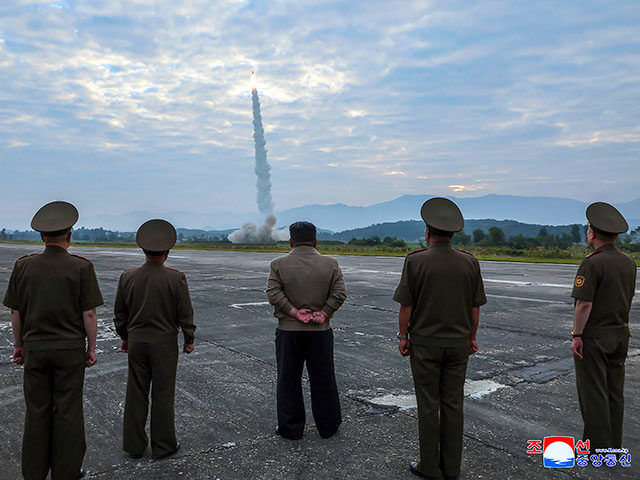North Korean state media claimed on Thursday that dictator Kim Jong-un oversaw a successful test of a new model of “tactical ballistic missile” that can carry a “super-large” warhead.
The test is the latest in a series of belligerent, and increasingly frequent, actions intended to intimidate its enemies, South Korea and the United States. In the past month, North Korea has dispatched dozens of balloons carrying trash into South Korea and, in an unprecedented move, published photos of what it claimed to be a uranium enrichment facility, intended to help Kim achieve an “exponential” growth in the number of nuclear weapons his regime possesses.
Kim Jong-un has also in the past year debuted what he claimed to be suicide drones and an “underwater nuclear weapon system.”
The Korean Central News Agency (KCNA), the flagship state media outlet of the communist North Korean regime, described the alleged missile tested on Thursday as a “Hwasongpho-11-Da-4.5,” in addition to the testing of “an improved strategic cruise missile.”
“The new-type tactical ballistic missile was tipped with a 4.5 tonnage super-large conventional warhead according to design,” KCNA claimed. “Its test-fire was aimed at verifying the accuracy of hit at medium range of 320 km [about 199 miles] and explosive power of the super-large warhead with a missile loaded with such a warhead.”
The test was allegedly a success and Kim proclaimed “great satisfaction” with the result.
“Our military superiority proved once again today is enough to judge the speed of development of the DPRK’s armed forces, he said,” according to KCNA, “stressing the need to continue to bolster up the nuclear force and have the strongest military technical capability and overwhelming offensive capability in the field of conventional weapons, too.”
The South Korean military confirmed that it had monitored launches of ballistic and cruise missiles on Thursday morning north of Pyongyang, but offered minimal details on the intelligence it collected, according to the South Korean Yonhap news agency. Yonhap noted that a “super-large warhead is among a list of high-tech weapons that Kim had vowed to develop at a party congress in 2021,” fulfilling one of several items of Kim’s advanced weaponry checklist.
Koreans are currently celebrating the autumn holiday of Chuseok, which marks the end of summer and the harvest season. The Korea JoongAng Daily observed on Thursday that Kim appears to have anticipated the holiday with an increase in belligerent activity, including another drop of an estimated 160 balloons full of trash over South Korean territory.
“So far, approximately 30 fallen objects have been identified in the northern part of Gyeonggi and Seoul,” the South Korean Joint Chiefs of Staff announced on Thursday. “Identified content includes household waste such as paper, vinyl and plastic bottles, and the analysis results show that nothing posed a safety risk.”
North Korea regularly attacks the South with balloons carrying trash, feces, and other undesirable materials as a form of humiliation. The trash balloon campaign escalated in May and has featured hundreds of balloon drops, prompting the South Korean government to re-install loudspeakers on the inter-Korean border to broadcast anti-communist material and South Korean pop music into the North. North Korea, as a repressive communist state, bans citizens from consuming any foreign media, but especially punishes the consumption of South Korean television, movies, and music. It also actively blocks its citizens from obtaining news about the outside world and reacts with fury to Seoul’s attempts to inform its citizens.
As for the missiles, the JoongAng newspaper noted that the first test launch of the “Hwasongpho-11-Da-4.5” ballistic missile is believed to have occurred in July, but failed, suggesting the North Korean military has improved its technology rapidly.
The newspaper also suggested that firing ballistic and cruise missiles simultaneously could potentially allow North Korea to “disrupt interception and tracking networks and confuse South Korean and U.S. authorities in their initial analysis.”
“Cruise missiles are slower than ballistic missiles because their maximum speed is below the speed of sound, and their destructive power is weaker,” the newspaper explained. “However, since they fly at the lowest possible altitude to avoid radar networks, additional surveillance and reconnaissance assets, such as satellites, are required to track them.”
The missile test followed North Korea’s decision a week ago to publish photos of what it claimed to be a uranium enrichment facility, claiming Kim had toured it to ensure that it was operating at a high enough speed to an “exponential” growth in the number of nuclear warheads in its arsenal.
“[Kim] stressed the need to set a higher long-term goal in producing nuclear materials necessary for the manufacture of tactical nuclear weapons,” KCNA relayed at the time, “and concentrate all efforts on bringing about fresh leap forward, setting forth important tasks and orientation.”
Kim Jong-un announced a plan to “exponentially” increase the number of nuclear weapons in his possession in January 2023. A report published in June by the Stockholm International Peace Research Institute (SIPRI) found that North Korea is believed to possess 50 nuclear warheads as of 2024, 20 more than it did in 2023.

COMMENTS
Please let us know if you're having issues with commenting.